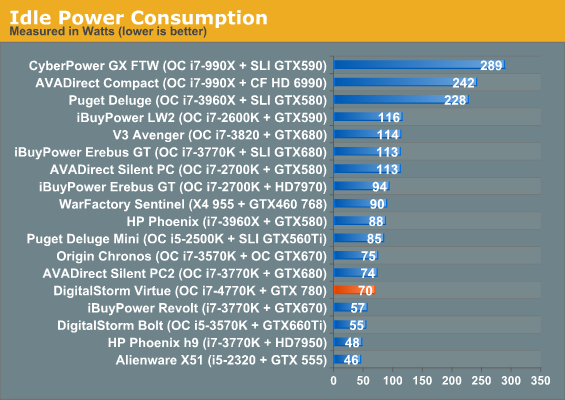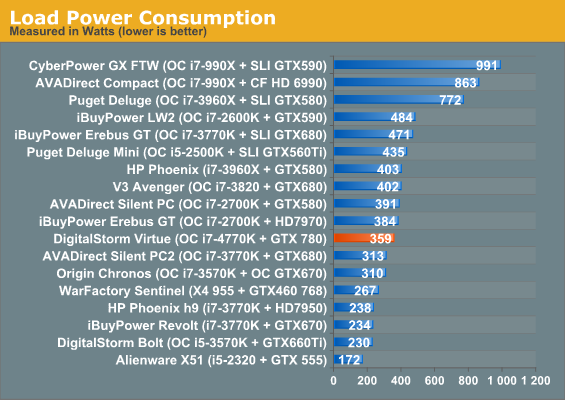Haswell and GK110 vs. Ivy and GK104: DigitalStorm Virtue System Review
by Dustin Sklavos on June 23, 2013 12:00 PM ESTBuild Quality
It's not entirely fair to DigitalStorm not to mention the generally excellent job they've done with the build quality of the Virtue. One of the ways a boutique can distinguish itself is in its component selection, and the stock component choices of the Virtue line are solid across the board.
Starting with the chassis selection, I'm actually a pretty big fan of the Corsair Obsidian 350D and I'm happy to see it being employed in a high performance system. Interestingly, DigitalStorm is also using Corsair's H100i to cool the CPU, but they're not employing Corsair Link software to control fan speed despite the system being wired to use it. Instead, the fans on the H100i (oriented beneath the radiator to pull in air from the top of the enclosure and then cycle it out of the rear exhaust) run at a fixed fan speed. I personally find variable fan speed to be distracting; I'd just as soon the whole system run silent all the time, end of discussion. DigitalStorm's choice here works for me.
.jpg)
The 350D also does an excellent job of showing off NVIDIA's reference cooler for the GeForce GTX 780, complete with the subtly glowing "GeForce GTX" logo. That's plugged into an ASUS Z87 Gryphon motherboard, and the system drive is a healthy 120GB Corsair Neutron GTX featuring an LAMD controller. Given all the Corsair kit in the Virtue, though, I'm actually surprised the memory is A-Data.
Where I'd be tempted to shake down DigitalStorm is in using a single stable voltage for overclocking the i7-4770K, but without more experience with Haswell and the quirks of its VRM I can't say if that's worth caring about or not. With the first generation chips (Nehalem, Clarksfield, Gulftown), this was a huge issue, but Sandy and Ivy were less problematic and it looks like Haswell is even less so. I do want to point out that DigitalStorm has traditionally been more aggressive about their CPU voltages than I'd like, but the i7-4770K's 1.28V is actually pretty common and totally reasonable.
Noise and Heat
Demonstrating a healthy amount of balance in their design, the Virtue isn't especially silent but is generally a touch quieter than enthusiast gaming desktops tend to be. Idle noise is around ~33dB, and since the CPU and chassis fans run at a fixed speed, the GeForce GTX 780 is really the only component that spins up or down. Unfortunately, while the 350D is an excellent case for liquid cooling, it does suffer slightly from Corsair's perpetual issues with middling air cooling performance.

Thermals on the GTX 780 are pretty par for the course, but it can jack noise levels up a couple of dB under sustained load. Meanwhile, the i7-4770K is really about where it needs to be. A more adventurous user might be able to eke a little more performance out of it with a little more juice, but I'd hesitate to push the H100i that much harder, especially without bumping the fan speeds up to a potentially uncomfortable volume.
Power Consumption
So how much power does a modern high end gaming system pull from the wall? The last couple of generations from Intel, NVIDIA, and AMD (Bulldozer/Piledriver notwithstanding) have all done an admirable job of continually reducing idle and load power consumption alike, so the DigitalStorm Virtue stands to benefit from those advances.


And it does. While neither one is abnormally spectacular, they're both totally reasonable. I'm not convinced DigitalStorm couldn't shave 10W or so off the idle power, but load power is where it ought to be.


_thumb.jpg)
_thumb.jpg)
_thumb.jpg)
_thumb.jpg)
_thumb.jpg)
_thumb.jpg)








70 Comments
View All Comments
cmdrdredd - Sunday, June 23, 2013 - link
Nice review. I too am unimpressed by Haswell, but even more unimpressed by the GTX 770. Basically an overclocked 680. Only the 780 is even worth mentioning IMO. That's just my opinion and since I am on SLI 670s I suppose my view is a little unfair.That all said these systems offer pretty good value for someone who wants a ready to go system right out of the box with no fuss. The pricing is extremely fair.
airmantharp - Monday, June 24, 2013 - link
The GTX770 is worth mentioning for the blower- it uses the Titan/GTX780 blower instead of the GTX680 blower. Lower temps, less noise, especially when pushed.But otherwise, you're right, it's unremarkable.
HisDivineOrder - Monday, June 24, 2013 - link
Actually, very few of those 770's with the Titan blower were made. Fewer still are being sold. In the US, they're all coming with custom coolers.sticks435 - Tuesday, June 25, 2013 - link
Evga is now bringing out a limited run of them, though with a higher price.kilkennycat - Wednesday, June 26, 2013 - link
Really ?? The only GTX770 with blower-style coolers listed on the US eVGA website as of 06/26 all have GTX680-type coolers, no Titan cooler.The Titan cooler requires a physical redesign of the GTX680 circuit board to accommodate the mechanics. It seems very odd to me that the nVidia reference design of the GTX770 sports the Titan cooler, but none of the partner-manufacturers offer that cooler as an option. I suspect that excess GTX680 circuit-board material and component inventory is currently being reallocated to GTX770 by installing the updated GK104 silicon and Boost2.0 firmware. Presumably after that material is used up, then Titan-style GTX770 may appear, probably at some price premium.
MattKatz - Thursday, October 9, 2014 - link
I'm not impressed by either one. The CybertronPC Borg-Q GM4213C is much better. /Matt from http://www.consumertop.com/best-desktop-guide/HisDivineOrder - Monday, June 24, 2013 - link
Hm. You're forgetting the price argument about the 770.The 770 isn't just an overclocked 680. It's an overclocked 680 at former 670 pricing. So not only are they giving you more than top end performance from the last card line, but they're selling it to you for $100 less.
Meanwhile, Haswell is nothing but absolute disappointment for the desktop user. Even for the laptop user who isn't buying an Ultrabook, I question much of its value. Haswell makes the most sense in Ultrabooks and in Razer Edge-esque tablets.
IanCutress - Sunday, June 23, 2013 - link
Wow, I didn't realise the Gryphon came with the ALC892. Would have assumed an ALC898 minimum. I would guess the money on that motherboard was spent on the TUF features first before the audio.Seems a little odd for a boutique build that ASUS is chosen for the motherboard, ASUS for the ODD, then EVGA with the GPU. Why not keep it all one company? Same with the memory - the case and PSU are Corsair, but the memory is ADATA? I'd assume that 'cost at the time' is the answer, but $2500 seems a lot for the whole system, or is that just me? [Insert self-build takes time over pre-built hence extra 10% on cost]
Dustin Sklavos - Sunday, June 23, 2013 - link
The margin on this build is actually a very reasonable one, comparatively. We're looking at probably around or a bit less than the 10%.aruisdante - Sunday, June 23, 2013 - link
Because EVGA' 1150 boards aren't out yet. It is odd they went with the Gryphon instead of the Genethough.